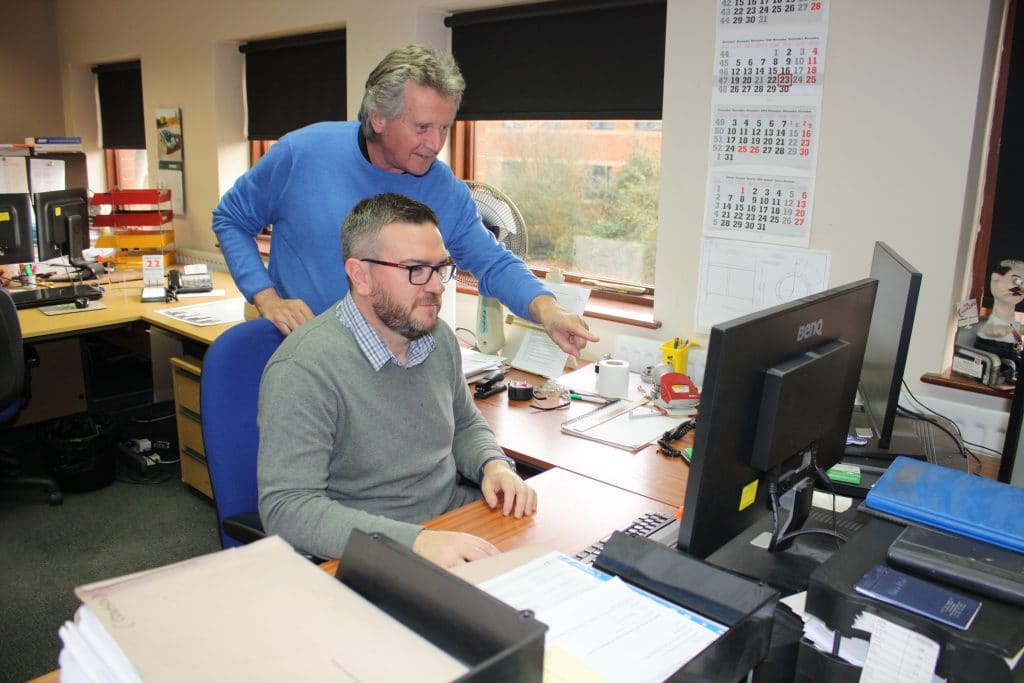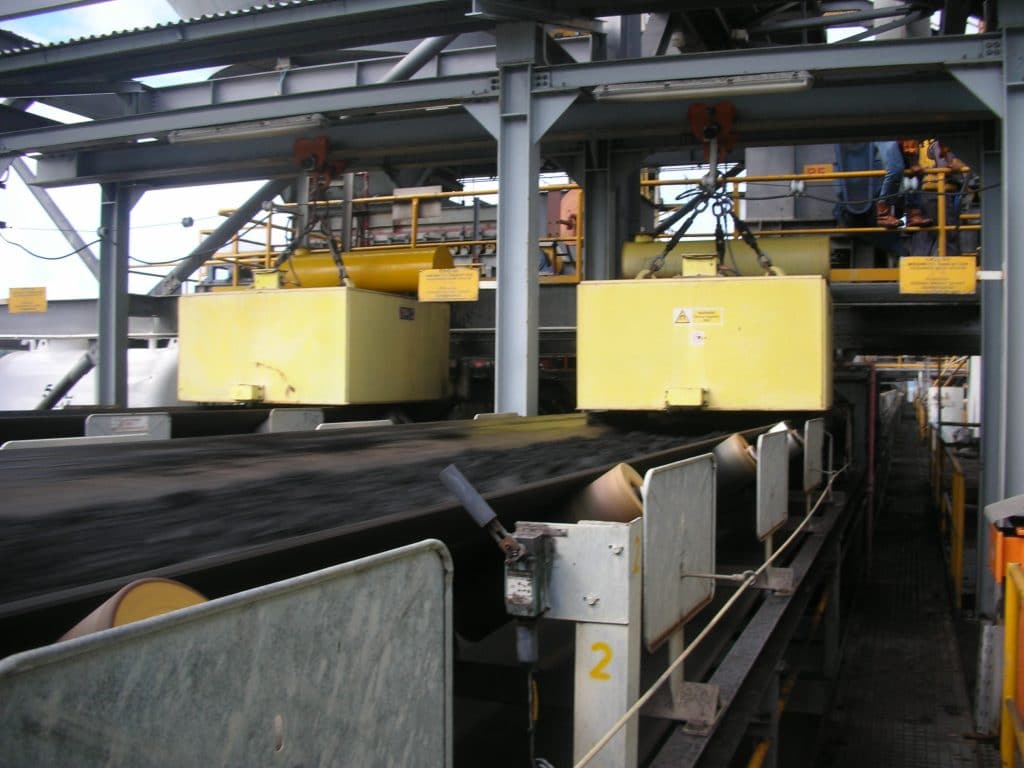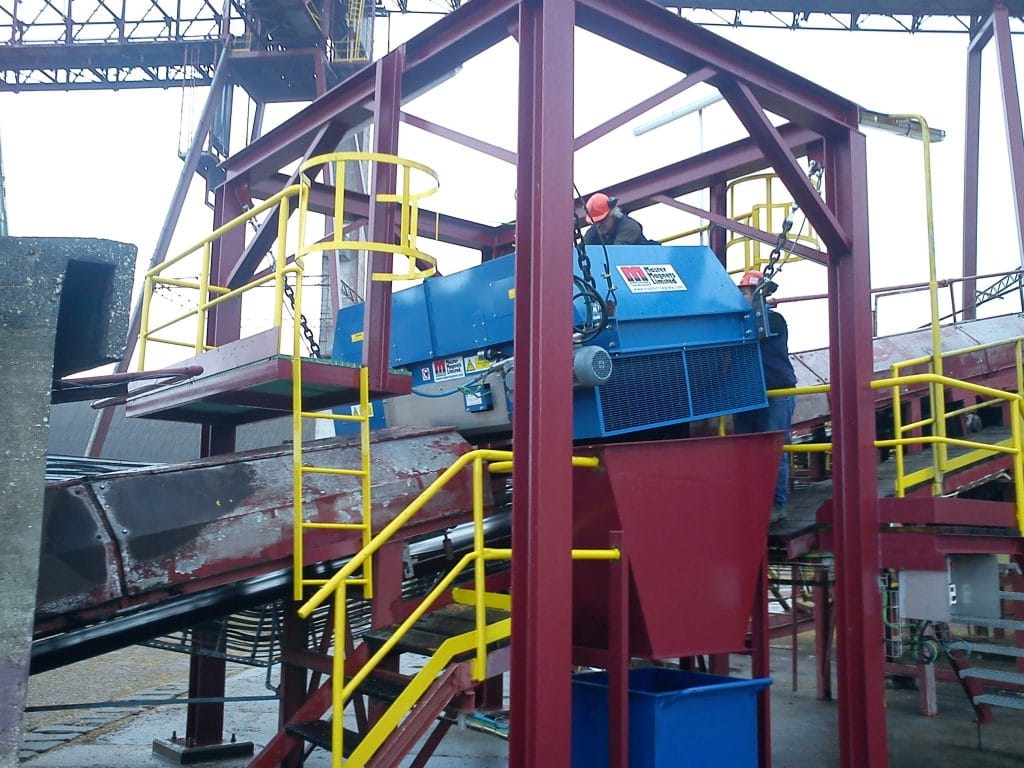Electro Overband Magnet Selection
By Paul Fears | 28 November 2018
The Bunting range of Electro Overband Magnets is extensive. Selecting the optimum design of Electro Overband Magnet to perform a specific separation task is critical to the successful separation of tramp metal. Poor magnet selection could result in damage to processing equipment or a reduction in product quality. To aid the correct selection, Bunting’s team of applications engineers have developed a bespoke ‘Electro Overband Magnet Selection Programme’.

Electro Overband Magnet Operation
In operation, an Electro Overband Magnet projects a magnetic field down and through a conveyed product (e.g. aggregate, coal, ore or recycled materials). This magnetic field is generated by an electromagnetic coil, steel core and steel back bar. Tramp ferrous metal present in the conveyed material is attracted by the magnetic field. The ferrous metal moves up off or through the conveyed material until it reaches the bottom most surface of the magnet. If the Electro Overband Magnet is a manual clean design, the tramp ferrous metal is held on the surface. For self cleaning designs, the tramp ferrous metal is attracted up to the surface of a moving belt and then discharged away from the conveyor.

Selection Criteria
The size and design of the Electro Overband Magnet to attract and extract the tramp ferrous metal depends on a number of operational criteria. Once inputted, the programme uses this key application data to automatically calculate the magnetic required magnetic force. This Force Density is a function of the gauss at distance and the rate of change of gauss. A gauss figure alone does not have any bearing on ‘separation’. Once this data has been assessed, the programme concludes the Force Density that is required and recommends the requisite Electro Overband Magnet. The required application information is in 5 separate sections:
Conveyor
- Belt speed (m/s) – This dictates how long the tramp ferrous metal will be in the magnetic field. It also determines the trajectory of the material once leaving the end of the conveyor;
- Trough angle (degrees) – Steeper troughs produce deeper burdens of material. Also, steeper troughs often mean that the Electro Overband Magnet needs to be suspended higher to ensure collected tramp metal can be efficiently removed without making contact with the edge of the conveyor;
- Belt width (mm) – The width of the conveyor belt dictates the size of the electro magnetic coil. The coil needs to project a magnetic field over the whole belt area;
Conveyed Material
- Burden depth (mm) – This relates to the maximum expected burden depth of conveyed material. The programme calculates the magnetic force needed to remove tramp ferrous metal on the surface of the conveyor, under the burden;
- Capacity (t/hr) – The maximum capacity per hour will cross relate to the maximum burden depth;
- Density (t/m3) – Stronger magnetic force may be required to remove tramp ferrous metal from denser and heavier materials;
- Water content (%) – Higher moisture levels can make a material denser. Higher magnetic forces may be required;
Tramp Ferrous Metal
- Length, Width, Height (mm) – Longer tramp ferrous metal (e.g. rods and bars) are easier to separate than cubes. The most difficult shape to separate is a sphere. The ferrous item may enter the magnetic field in different orientations. In consideration of this fact, the programme automatically calculates separate extraction percentages for three possible orientations. An average is then calculated to represent the overall probability of removing that particular tramp ferrous metal shape;
Electro Overband Magnet
- Suspension height (mm) – The suspension height will be calculated on the basis of the burden depth of the conveyed material, trough angle of the conveyor, and the size of the tramp ferrous metal (to ensure the metal clears the edge of the conveyor belt if self-cleaning);
- Magnet orientation – The Electro Overband Magnet can be suspended is 3 different ways:
- At 90 degrees across the conveyor (Crossbelt);
- At an oblique angle across the conveyor (Crossbelt);
- Over the head pulley of the conveyor (Inline);

Environmental Factors
Other criteria, often ignored, are the environmental factors such as:
- Altitude (m above sea level) – The ability for an Electro Overband Magnet to dissipate heat becomes difficult at higher altitudes due to the lower air density. Accounting for this important environmental factor may result in a larger model being selected. Operating the magnet at 75% of the maximum reduces the operating temperature. Subsequently, less heat needs to be dissipated by the thin air;
- Ambient temperature (degrees C) – As the Electro Magnetic Coil gets hot during operation, the design needs to consider whether the external temperature is warmer or colder. In a warm climate, it may be necessary to select a slightly larger magnetic coil. This will allow heat dissipation and ensure the electro magnet performance meets the separation criteria;
Selection
The inputted data will recommend specific sizes of Electro Overband Magnet. The applications engineer will then review the whole application and determine the best Electro Overband Magnet for the project. This bespoke programme has been used by the Master Magnets team to select hundreds of Electro Overband Magnets. The combination of the programme, using known mathematical data, and the experience of the engineering team ensures that the best Electro Overband Magnet is selected for every project.
Related Electro Overband Magnet Articles
- Electro Overband Magnet Removes Metal from Copper Ore;
- Large Electro Suspension Magnets at West Burton Power Station;
- Electro Overband Magnets Protect Waste Shredders;
- 10 Tonne Electro Overbands Installed in Russian Coal Processing Plant;
Contact Us
For additional information on any size of Electro Overband Magnet or Permanent Overband Magnet, or if you require any information on magnetic separation products or any of the services we have available at Bunting, please contact us on:
Email: GKerr@BuntingMagnetics.com
Telephone: +44 (0) 1527 65858
Follow us on social media